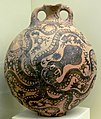Minoan pottery
As Minoan ceramics or Creto-Minoan ceramics , ceramic styles of the Minoan culture are summarized, which can be found in the Bronze Age Crete between about 2800 and 1100 BC. Developed. Minoan vase painting had its peak in the time of the Old and New Palaces (2000–1400 BC). As an indicator, Minoan pottery also plays a major role in Minoan chronology.
history
Pre-palace period
Even before the first Cretan palaces were built, there were considerable innovations in the ceramics industry: the fast-rotating potter's wheel , which was probably developed in Mesopotamia, was introduced in Crete. As this made production much faster, the potters developed new ceramic styles with increasing skill, among which the Vassiliki style and the Pyrgos style played a leading role. Other styles of the pre-palace period were the early pre-palace period Agios Onouphrios style and the white style .
Old palace time
In the old palace period , the Kamares style was the first heyday of Cretan-Minoan ceramics. The vessels are characterized by very thin walls and abstract paintings, mostly with red or white paint on the black background. Because of their thin walls, they are also known as eggshell goods.
New Palace period
With the beginning of the second palace period , the Minoan painters turned back to motifs from nature with the flora style and the sea style . Flora style vessels are often decorated with lilies, papyrus bushes or flowers, saffron, iris and foliage. Popular motifs of the marine style, however, were octopus, purple snail, nautilus, starfish and corals.
In the last phase of Minoan vase painting, the palace style emerged. There are again signs of geometrical rigor. The production of vessels painted in this style was limited to Knossos .
The main elements are ritual and sacral representations as well as lions and bulls' heads. Simple vessels were often decorated geometrically. The colors were mostly red, brown, black and white. Special forms of vessel were various jugs .
The ancient historian Angelos Chaniotis writes about this: " ... the Minoan ceramics arouse ... admiration through ... technical ability ... and suggests a feeling of the Cretans' love of nature and life ..."
literature
- Brockhaus archeology. High cultures, excavation sites, finds. Brockhaus, Mannheim et al. 2009, ISBN 978-3-7653-3321-7 .
- Manolis Andronicos : Heraklion Museum. Ekdotike Athenon SA, Athens 1990, ISBN 960-213-024-5 , pp. 10-11.
Web links
Individual evidence
- ↑ Angelos Chaniotis: The ancient Crete (= Beck'sche series 2350 C.-H.-Beck knowledge ). Beck, Munich 2004, ISBN 3-406-50850-2 , p. 28 ( digitized version ).




